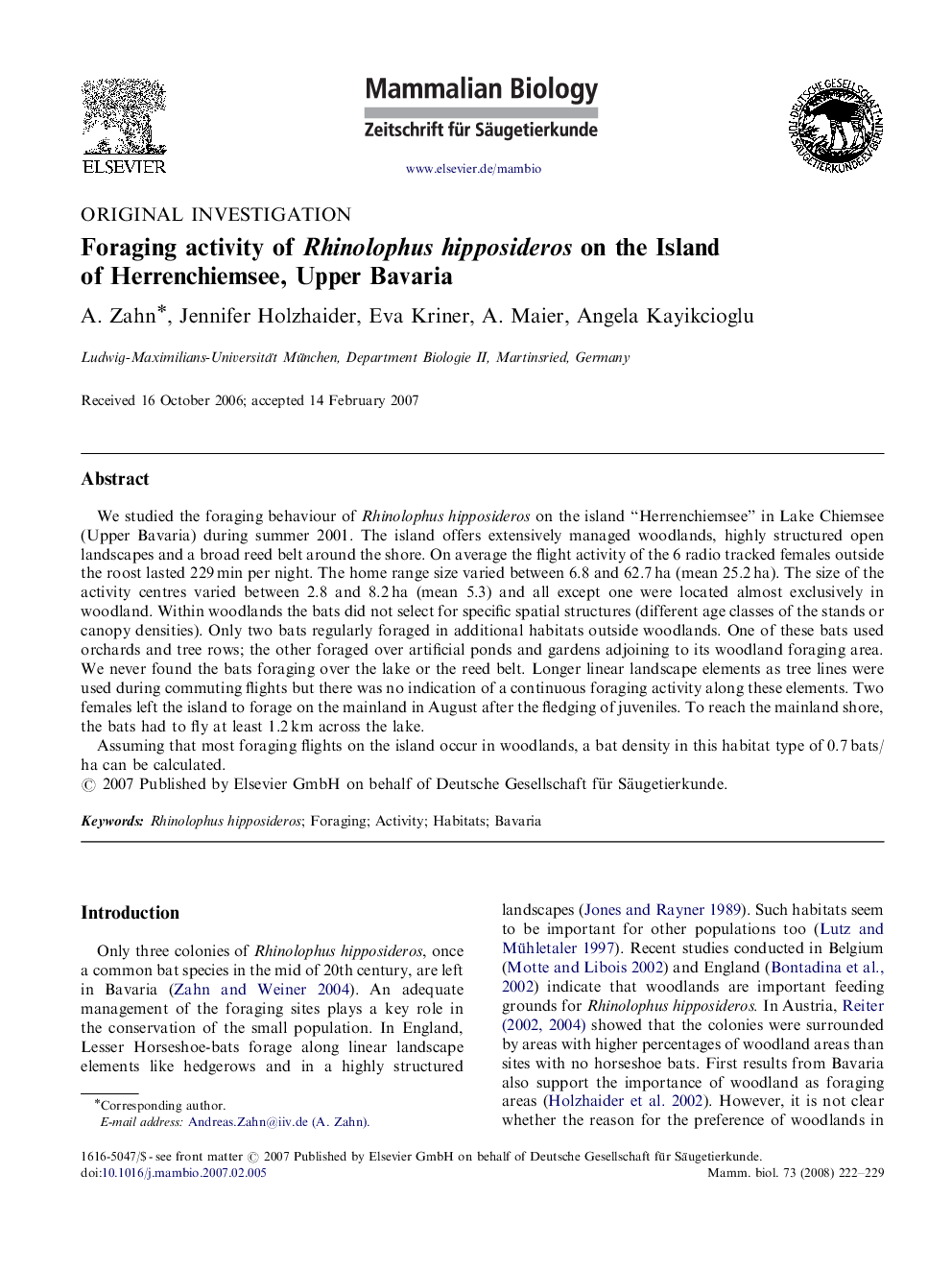| کد مقاله | کد نشریه | سال انتشار | مقاله انگلیسی | نسخه تمام متن |
|---|---|---|---|---|
| 2194257 | 1098426 | 2008 | 8 صفحه PDF | دانلود رایگان |

We studied the foraging behaviour of Rhinolophus hipposideros on the island “Herrenchiemsee” in Lake Chiemsee (Upper Bavaria) during summer 2001. The island offers extensively managed woodlands, highly structured open landscapes and a broad reed belt around the shore. On average the flight activity of the 6 radio tracked females outside the roost lasted 229 min per night. The home range size varied between 6.8 and 62.7 ha (mean 25.2 ha). The size of the activity centres varied between 2.8 and 8.2 ha (mean 5.3) and all except one were located almost exclusively in woodland. Within woodlands the bats did not select for specific spatial structures (different age classes of the stands or canopy densities). Only two bats regularly foraged in additional habitats outside woodlands. One of these bats used orchards and tree rows; the other foraged over artificial ponds and gardens adjoining to its woodland foraging area. We never found the bats foraging over the lake or the reed belt. Longer linear landscape elements as tree lines were used during commuting flights but there was no indication of a continuous foraging activity along these elements. Two females left the island to forage on the mainland in August after the fledging of juveniles. To reach the mainland shore, the bats had to fly at least 1.2 km across the lake.Assuming that most foraging flights on the island occur in woodlands, a bat density in this habitat type of 0.7 bats/ha can be calculated.
ZusammenfassungIm Sommer 2001 wurde die Jagdaktivität und die Habitatwahl der Kleinen Hufeisennase (Rhinolophus hipposideros) auf Herrenchiemsee untersucht. Potentielle Jagdlebensräume auf der Insel sind extensiv genutzte Wälder, strukturreiches Offenland und ein breiter Schilfgürtel am Ufer. Im Schnitt betrug die nächtliche Flugaktivität der 6 besenderten Weibchen außerhalb des Quartiers 229 Minuten. Die Größe der Streifgebiete variierte zwischen 6,8 und 62,7 ha (Mittelwert 25,2 ha), die Größe der Aktivitätszentren zwischen 2,8 and 8,2 ha (Mittelwert 5,3). Mit nur einer Ausnahme lagen die Aktivitätszentren fast vollständig im Wald. Dabei konnte keine Bevorzugung bestimmter Waldstrukturen (unterschiedlich alte oder dichte Bestände) festgestellt werden. Nur zwei Tiere jagten regelmäßig auch außerhalb des Waldes. Eines flog in Obstgärten und Alleen, das andere Weibchen jagte an Brunnen und Gartenanlagen, die an sein Jagdgebiet im Wald angrenzten. See und Schilfgürtel wurden nicht genutzt. An linearen Landschaftselementen wie Hecken orientierten sich die Hufeisennasen beim Flug in die Jagdgebiete, doch fand dort keine längere Jagdaktivität statt. Nach dem Flüggewerden der Jungen im August querten zwei Weibchen mehrmals den See um am Festland zu jagen. Um das andere Ufer zu erreichen, mussten sie mindestens 1,2 km über die offene Seefläche fliegen.Unter der Annahme, dass sich die Jagdaktivität auf der Insel in Wäldern konzentriert, lässt sich für diesen Habitattyp die Dichte von 0,7 Hufeisennasen/ha berechnen.
Journal: Mammalian Biology - Zeitschrift für Säugetierkunde - Volume 73, Issue 3, 1 May 2008, Pages 222–229